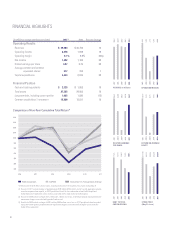Federal Express 2011 Annual Report Download - page 18
Download and view the complete annual report
Please find page 18 of the 2011 Federal Express annual report below. You can navigate through the pages in the report by either clicking on the pages listed below, or by using the keyword search tool below to find specific information within the annual report.
16
MANAGEMENT’S DISCUSSION AND ANALYSIS
Seasonality of Business
Our businesses are cyclical in nature, as seasonal fluctuations affect
volumes, revenues and earnings. Historically, the U.S. express pack-
age business experiences an increase in volumes in late November
and December. International business, particularly in the Asia–to–U.S.
market, peaks in October and November in advance of the U.S. holiday
sales season. Our first and third fiscal quarters, because they are
summer vacation and post winter–holiday seasons, have historically
experienced lower volumes relative to other periods. Normally, the fall
is the busiest shipping period for FedEx Ground, while late December,
June and July are the slowest periods. For FedEx Freight, the spring
and fall are the busiest periods and the latter part of December,
January and February are the slowest periods. For FedEx Office, the
summer months are normally the slowest periods. Shipment levels,
operating costs and earnings for each of our companies can also be
adversely affected by inclement weather, particularly the impact of
severe winter weather in our third fiscal quarter.
NEW ACCOUNTING GUIDANCE
New accounting rules and disclosure requirements can significantly
impact our reported results and the comparability of our financial
statements. New accounting guidance that has impacted our financial
statements can be found in Note 2 of the accompanying consolidated
financial statements.
In June 2011, the Financial Accounting Standards Board issued new
guidance to make the presentation of items within other comprehen-
sive income (“OCI”) more prominent. The new standard will require
companies to present items of net income, items of OCI and total
comprehensive income in one continuous statement or two separate
consecutive statements, and companies will no longer be allowed
to present items of OCI in the statement of stockholders’ equity.
Reclassification adjustments between OCI and net income will be
presented separately on the face of the financial statements. This
new standard is effective for our fiscal year ending May 31, 2013.
We believe there is no additional new accounting guidance adopted
but not yet effective that is relevant to the readers of our financial
statements. However, there are numerous new proposals under devel-
opment which, if and when enacted, may have a significant impact on
our financial reporting.
REPORTABLE SEGMENTS
FedEx Express, FedEx Ground and FedEx Freight represent our major
service lines and, along with FedEx Services, form the core of our
reportable segments. Our reportable segments include the following
businesses:
Effective January 30, 2011, our FedEx Freight and FedEx National LTL
businesses were merged into a single operation. FedEx Freight now
offers two standard services: FedEx Freight Priority, a faster transit
service with a price premium; and FedEx Freight Economy, an economi-
cal service.
FEDEX SERVICES SEGMENT
The FedEx Services segment operates combined sales, marketing,
administrative and information technology functions in shared services
operations that support our transportation businesses and allow us to
obtain synergies from the combination of these functions. The FedEx
Services segment includes: FedEx Services, which provides sales,
marketing and information technology support to our other compa-
nies; FedEx TechConnect, which is responsible for customer service,
technical support, billings and collections for U.S. customers of our
major business units; and FedEx Office, which provides an array of
document and business services and retail access to our customers for
our package transportation businesses. Effective September 1, 2009,
FedEx Express Segment
>
FedEx Express
(express transportation)
>
FedEx Trade Networks
(global trade services)
>
FedEx SupplyChain Systems
(logistics services)
FedEx Ground Segment
>
FedEx Ground
(small–package ground delivery)
>
FedEx SmartPost
(small–parcel consolidator)
FedEx Freight Segment
>
FedEx Freight
(LTL freight transportation)
>
FedEx Custom Critical
(time–critical transportation)
FedEx Services Segment
>
FedEx Services
(sales, marketing and information
technology functions)
>
FedEx TechConnect
(customer service, technical support,
billings and collections)
>
FedEx Office
(document and business services and
package acceptance)
























